 Image search results - "fukagawa" Image search results - "fukagawa" |

Every three years (2017, 2020, 2023, 2026, etc.), the full-scale version of this festival is held in mid-Aug. The festival's last day is the climax with this procession of over 50 portable shrines. Led by this banner which reads Tomioka Hachimangu.
|
|

Shrine priest on horseback. The start of one of Tokyo's Big Three Festivals. These photos show the festival's climax on the last day of the festival when over 50 portable shrines are paraded along the streets amid splashing water. It is the Rengo
|
|

Omiko shrine maidens. On the previous day during the Sacred Carriage Procession, they performed sacred dances on a truck. お巫女
|
|

Tekomai geisha. Their costume is colorful and partially masculine with trousers instead of skirts. Their right shoulder is "exposed" to show a peony flower (botan) design. They carry a red paper lantern imprinted with their names.
|
|

Tekomai geisha. They existed since the Edo Period. They served as side entertainment at festivals. They only sing traditional chant-like songs called kiyari. 手古舞
|
|

This troupe of 25 local women preserve a traditional art of Edo. They attend regular singing practice led by an elderly woman who was an authentic tekomai in her day.
|
|

Road to the Fukagawa-Edo Museum, near Kiyosumi-Shirakawa Station.
|
|

This is early in the morning when the 54 portable shrines who had gathered in front of the shrine depart for the procession one after another.
|
|

Fukagawa-Edo Museum
|
|

In front of Tomioka Hachimangu Shrine on Eitai-dori road.
|
|

After you enter the exhibition area, first you see drawings of famous people from Fukagawa.
|
|
|

Then you see a dramatic bird's eye view of the recreated neighborhood of Sagacho, Fukagawa. The entire neighborhood is indoors.
|
|
|

The lighting inside the museum also changes to reflect the time of day. This is night time.
|
|

As the mikoshi depart, there is some entertainment at the Tomioka Hachimangu Shrine.
|
|

Day time
|
|

Taiko drummers at Tomioka Hachimangu Shrine.
|
|

Rice storehouse
|
|

In front of the shrine, a shrine priest blesses each portable shrine as it departs to join the procession.
|
|

Cat on the roof. Meow is what you first hear in the museum. Its name is "Mamesuke." Actually a robot cat whose head can move up and down.
|
|

The portable shrines are paraded through a route which will take them almost all day to complete, from 7:30 am to 3 pm.
|
|

Main street with shops.
|
|

The mikoshi are splashed with water in whichever way possible. This is in the middle of summer, so it's a good way to cool off.
|
|

Vegetable seller. 八百屋の八百新
|
|

Each mikoshi is preceded by a row of women carrying lanterns and wands. Also see the video at YouTube
|
|

Back room of the vegetable seller.
|
|

People in happi coats carry the mikoshi while shouting "Wasshoi, wasshoi!"
|
|
|
|
|

Standard uniform of portable shrine bearers (for both men and women).The headband may be tied at the front or back of the head. It may also be tied on the head like a bonnet. There is a variety of ways of tying the headband.
The happi coat bears the name of the parish or district the person belongs to. The same name is displayed on the respective portable shrine. The shorts are white and skintight. Worn by both men and women. Also called Han-momo or Han-momohiki. The white tabi (sock-like shoe) has a rubber sole.
|
|

Rice vendor. A small, wooden square box was used to measure the volume of rice to sell to a customer. 舂米屋職人
|
|

Bales of rice inside the rice storehouse.
|
|
|

Machikido town gate made of wood. This gate marked the boundary between towns. It could also be closed. 町木戸
|
|
|

River boat taxi
|
|

"Hey Ho, Let's Go!"
|
|

River boat taxi
|
|
|

Fire watchtower on the left, and boat operator's house on the right. 船宿升田屋と相模屋
|
|
|

This mikoshi is being carried by all women, already soaked to the bone. They carry the mikoshi flat on their shoulders. This is called "Hira katsugi," literally "flat carrying."There are four basic methods of carrying a portable shrine. This is the most basic method where they carry it flat on their shoulders. This is called "Hira katsugi," literally "flat carrying."
|
|

Boat operator's house 船宿升田屋と相模屋
|
|
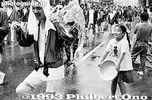
Splash you. This is a day when kids can be mean to grown-ups. This little girl kept filling up her bowl and ran around splashing some unlucky person.I hope that's her school teacher.
|
|

Cross section of a typical Nagaya longhouse apartment.
|
|

Nagaya longhouse
|
|

Water splashing truck near Kiyosu-bashi Bridge
|
|

Cross section of a typical Nagaya longhouse apartment. It was a single room whose size was about 6 tatami mats.
|
|

Water hose at Kiyosu-bashi Bridge
|
|

Cross section of a typical Nagaya longhouse apartment. The saw on the wall indicates that the resident was a log cutter. The area was close to Kiba where they processed logs.
|
|

Crossing Kiyosu-bashi Bridge over Sumida River.
|
|

Clothes line for laundry.
|
|

Crossing Kiyosu-bashi Bridge
|
|

Communal toilet
|
|

Crossing Kiyosu-bashi Bridge
|
|

In front of the fire watchtower is this open area designed as a fire break to prevent any fires from spreading further. It is also a gathering place with food stalls.
|
|

Raising the mikoshi on Kiyosu-bashi Bridge
|
|

Crossing Kiyosu-bashi Bridge. They chant "wasshoi wasshoi!" as they carry the mikoshi. 清洲橋
|
|
|
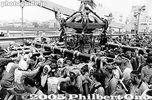
Crossing Kiyosu-bashi Bridge
|
|

Video theater
|
|

Exhibition room
|
|
|

With raised arms, this is one way to carry the mikoshi.
|
|

Tekomai geisha from Tomioka Hachimangu Shrine walk toward the stage.
|
|

A horde of people follow each portable shrine.
|
|

They perform in mid-Oct. on the same day and place as Kiba Kakunori log rolling.
|
|
|
|

Their right shoulder is "exposed" to show a peony flower design. Also see the video at YouTube.
|
|
|

They carry a red paper lantern imprinted with their names and use their right hand to drag along a metal wand.
|
|
|
|
|
|
|
|
|
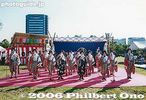
Tomioka Hachiman Tekomai geisha perform at Kiba Park.
|
|
|
|

Phoenix atop a portable shrine.
|
|
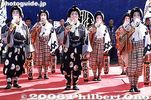
They only chant, no dancing.
|
|

Kiyosu-bashi Bridge over the Sumida River, Important Cultural Property 清洲橋 国の重要文化財
|
|

Tomioka Hachiman tekomai geisha
|
|

Crossing over Eitai-bashi Bridge. 永代橋
|
|

Tomioka Hachiman tekomai geisha
|
|

Tekomai geisha cross Eitai-bashi Bridge to enter Koto Ward along Eitai-dori.
|
|
|
|
|
|
|
|
|
|

手古舞
|
|
|
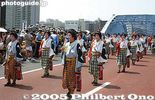
Tekomai geisha at Eitai-bashi
|
|
|
|

Tekomai geisha at Eitaibashi
|
|

During the finale, the tekomai and Kiba Kiyari singers sing together.
|
|

Tekomai geisha
|
|

They sing and chant while walking slowly.
|
|
|
|

They have flower hats, but I've never seen them wear it on their heads.
|
|

Tekomai geisha on Eitai-dori road, entering Koto Ward
|
|
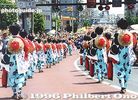
They do not get water splashed.
|
|
|
|

Fukagawa Tekomai geisha make their entrance. 深川手古舞
|
|

A portable shrine crosses Eitai-bashi Bridge.
|
|
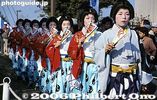
The Fukagawa Tekomai geisha make their way to the stage.
|
|

A portable shrine crosses Eitai-bashi Bridge.
|
|

They chant without instruments.
|
|

Another portable shrine crosses Eitai-bashi Bridge.
|
|

Using a water hose is an efficient way to get people wet. But see what the big boys use..
|
|
|

A fire hose. The local fire department with a fire hose on Eitai-dori avenue.
|
|
|

The water hose is now handled by volunteers, not real firemen.
|
|

Each carry a lantern bearing their name.
|
|

Every time, the water hoses are at the same location.
|
|

They always carry a flower hat, but I've never seen them wear it.
|
|

Water spray
|
|
|
|
|
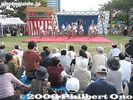
The stage in Kiba Park and spectators.
|
|
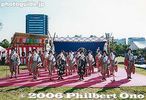
Fukagawa Tekomai Geisha performing at Kiba Park, Koto Ward, Tokyo.
|
|

Wet face
|
|
|
|
|

Crowd on Eitai-dori road
|
|
|

After crossing Eitai-bashi Bridge, the portable shrines headed for the main stretch on Eitai-dori avenue already filled with people. The wettest and most crowded part of the festival is held along this one kilometer of road between the bridge and shrine.
|
|
|
|
|

This is the final stretch and wettest part of the festival.
|
|
|

Prepared for the water...
|
|
|
|
|

A large truck filled with water with people using buckets to splash water in rapid succession.
|
|
|

View from behind the "water truck." This goes on for about 15 seconds. The truck is refilled with a fire hose. All in the name of purification.
|
|
|
|

During a break, two kids get water.
|
|
|
|
|
|

Fukagawa Hachiman Matsuri, mizu-kake
|
|

The mikoshi is raised high as they all bathe in water. Taking photos like this one requires adequate water protection of your camera and lens.
|
|
|

Onegaishimasu! お願いします!
|
|
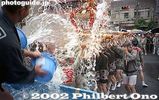
Hai, OK (ha-ha!).
|
|
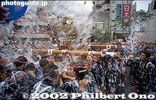
For some reason, it's fun to see people get wet...
|
|

Getting wet upside down might be an extra thrill...
|
|

In front of the water truck. Soon to be filled with people and a portable shrine.
|
|
|
|

After the tekomai geisha was the final act of the day. They were performed Fukagawa Strongman's Stunts. 深川の力持
|
|
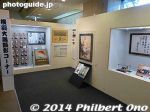
In the museum lobby is a special exhibition about Yokozuna Taiho, one of the greatest yokozuna in history. His sumo stable (Taiho Beya) was in Koto.
|
|

My video of a water truck splashing water on mikoshi.
|
|
|

Fukagawa Chikara-mochi
|
|
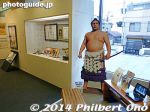
Yokozuna Taiho exhibition corner.
|
|

Wet women
|
|

Fukagawa Chikara-mochi is traditional entertainment spawned by warehouse workers in Sagacho (near Kiba), Tokyo during the Edo Period.
|
|
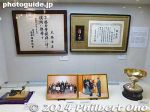
Yokozuna Taiho's awards.
|
|

Large crowd watch the mikoshi parade near Tomioka Hachimangu Shrine on Eitai-dori road.
|
|

They carried bags of rice, barrels of sake, etc., and tossed them in the air. It became a contest for skill and strength. Their stunts are reenacted here for this festival.
|
|
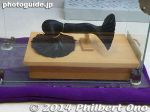
Yokozuna Taiho's topknot.
|
|
|
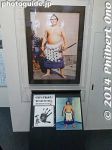
Portrait of Yokozuna Taiho and his handprint.
|
|
|
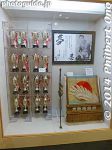
Yokozuna Taiho's tournament victories.
|
|
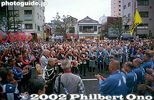
Hand clapping
|
|
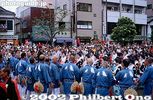
The tekomai geisha arrives at Tomioka Hachimangu Shrine.
|
|

The tekomai geisha enter the shrine.
|
|
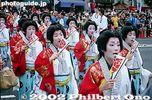
The tekomai geisha enter the shrine.
|
|
|
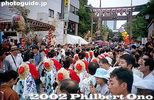
The tekomai geisha enter Tomioka Hachimangu Shrine.
|
|

As the portable shrines reach the shrine, they give one last show before returning to their parish.
|
|

My video of Fukagawa Tekomai performing at Kiba Park in Oct.
|
|

Tossing a mikoshi.
|
|

The portable shrine gets a final mid-air toss while passing by Tomioka Hachimangu Shrine. This mid-air toss of the portable shrine is called "mai-age" or tossing up.
|
|

Crowd at the shrine entrance.
|
|

One after another, the mikoshi arrives in front of the shrine.
|
|

And give their last show.
|
|
|
|
|

Being at the shrine's torii entrance is a great place to watch the mikoshi.
|
|
|
|
|
|
|
|
|
|
|
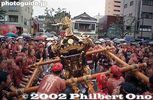
Dramatic display of mikoshi maneuvers
|
|
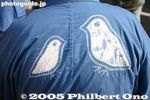
The shrine's happi coat has a design for the character "Hachi" (for Hachimangu) consisting of two pigeons. Pigeons are regarded as the messengers of the deity worshipped at Hachimangu shrines in Japan.
|
|

The stunts gradually get more difficult and dramatic.
|
|
|
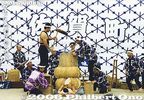
Preparing for the finale.
|
|
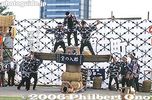
Almost 1,000 kg is on this man below. This stunts were also performed at Ueno Park for US President Ulysses S. Grant when he visited Japan in 1879 after his term ended.
|
|
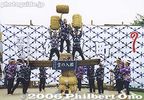
As one man lies at the bottom, everything is piled up on him. They even swayed the boat.
|
|

My 2010 video of Fukagawa Chikara-mochi in Kiba Park.
|
|

Facing Eitai-dori road, the main entrance to Tomioka Hachimangu Shrine. The original shrine fronted the ocean, but landfills over the centuries have put the shrine further away from shore.
|
|

Stone marker for Tomioka Hachimangu Shrine.
|
|

Main O-torii gate. The shrine holds various ceremonies and events including an antique flea market. The Fukagawa Hachiman Festival is its most famous festival held annually. The Hon-matsuri full-scale version held every three years (2008, 2011, 2014, etc.
|
|
|
|
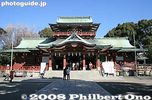
Tomioka Hachimangu Shrine, Honden worship hall. Koto-ku, Tokyo 富岡八幡宮 本殿
|
|

Tomioka Hachimangu Shrine, Honden worship hall
|
|

Inside Honden worship hall
|
|

Inside Honden worship hall
|
|

The shrine has close historical ties to sumo. Sumo has existed in Japan since at least the 8th century, but modern sumo began to take shape only during the Edo Period from the 17th to 19th centuries.
|
|

During the Edo Period, sumo became more organized and professional. It began with fund-raising sumo tournaments (kanjin-zumo) held at Shinto shrines and Buddhist temples to raise money for the shrine or temple's building construction and repair.
|
|

In 1684, government permission was granted for holding fund-raising sumo tourneys on the grounds of the Tomioka Hachimangu Shrine. Sumo tournaments were then held every year at the shrine.
|
|

Yokozuna Rikishi Monument (Yokozuna Rikishi-hi) at Tomioka Hachimangu Shrine, Koto Ward, Tokyo 横綱力士碑
|
|

Main stone of Yokozuna Rikishi Monument is inscribed with "Yokozuna Rikishi-hi" (横綱力士碑) which means Yokozuna Monument.
|
|

The left stone has a drawing of Yokozuna Shiranui.
|
|

The right stone shows Yokozuna Jimmaku Kyugoro.
|
|

Shiranui verses...
|
|

Jimmaku
|
|

On the right of the centerpiece stone is this newer stone (added in 1983) inscribed with the names of the most recent yokozuna.
|
|

The stone has three rows with seven names each.
|
|

In the top row, we can see from right to left: Asashio, Kashiwado, Taiho, Tochinoumi, Sadanoyama, Tamanoumi, and Kitanofuji. Inscribed are the ring name, hometown, and yokozuna promotion date.
|
|

In the middle row, from right to left: Kotozakura, Wajima, Kitanoumi, Wakanohana (II), Mienoumi, Chiyonofuji, and Takanosato.
|
|

On the bottom row, right to left: Futahaguro, Hokutoumi, Onokuni, Asahifuji, Akebono, Takanohana, and Wakanohana (III).
|
|

Since the front side of this stone is full, it continues on the back as you can see here.
|
|

From right to left: Musashimaru, Asashoryu, and Hakuho. Whenever a new yokozuna is promoted, a name inscription ceremony is held here.
|
|

The centerpiece stone is a 3.5-meter tall, 20-ton monument made in 1900 by the 12th yokozuna Jinmaku Kyugoro after collecting donations from business and political circles.
|
|

Behind the centerpiece stone are 45 yokozuna names (from the first yokozuna up to Wakanohana I) inscribed.
|
|

Names of the first to fifth yokozuna on the centerpiece stone. The first yokozuna was Akashi Shiganosuke. The Edo Period's golden age of sumo was during the time of the 4th yokozuna Tanikaze and 5th yokozuna Onogawa around 1789.
|
|

Names of yokozuna inscribed on the back of the centerpiece stone.
|
|

Names of yokozuna inscribed on the back of the centerpiece stone.
|
|

Names of yokozuna inscribed on the back of the centerpiece stone. On the extreme left is Raiden's name, a special case who was never promoted to Yokozuna, but was certainly Yokozuna material during the Edo Period..
|
|

At the time, only two ten-day tournaments were held annually in front of several thousand people. The sumo ring was located at the site of the present primary school next to the shrine.
|
|

During the years when tournaments were held at the shrine, professional sumo saw many important developments such as the incorporation of the yokozuna dohyo-iri (ring-entering ceremony), the establishment of the banzuke (sumo wrestler ranking sheet),
|
|

and the opening of sumo stables. Fukagawa (the area where the shrine is located) in effect became the birthplace of modern sumo.
|
|

The third stone awaits (still blank).
|
|

In 1791, the fund-raising sumo tournaments were moved to Eko-in temple in Ryogoku. In 1833, official sumo tournaments started at Eko-in temple. In 1909, the first and original Kokugikan sumo arena was subsequently built next to the temple.
|
|

The Yokozuna Rikishi Memorial Monument is also flanked by this smaller monument on the left. This is for sumo rikishi who acheived more than 50 consecutive wins.
|
|

This Rikishi Monument for Over 50 Consecutive Wins has 10 sides, and only five sides are inscribed with names. Which means only five rikishi have achieved more than 50 consecutive wins. One of them is Chiyonofuji.
|
|

Yokozuna Jimmaku Kyugoro
|
|

Although the shrine no longer hosts sumo tournaments, it has maintained close ties to sumo ever since. As of 2008, Koto Ward has several sumo stables (Taiho, Kitanoumi, Musashigawa, Kasugayama, Oshiogawa, Ajigawa, and Tomozuna).
|
|

Ozeki Rikishi Monument 大関力士碑
|
|

The Ozeki Rikishi Monument includes two stones inscribed with the names of Ozeki (those who never reached Yokozuna).
|
|
|
|

The most recent name inscribed is Kirishima (as of Feb. 2008).
|
|

Stone for handprints and footprints.
|
|
|
|
|